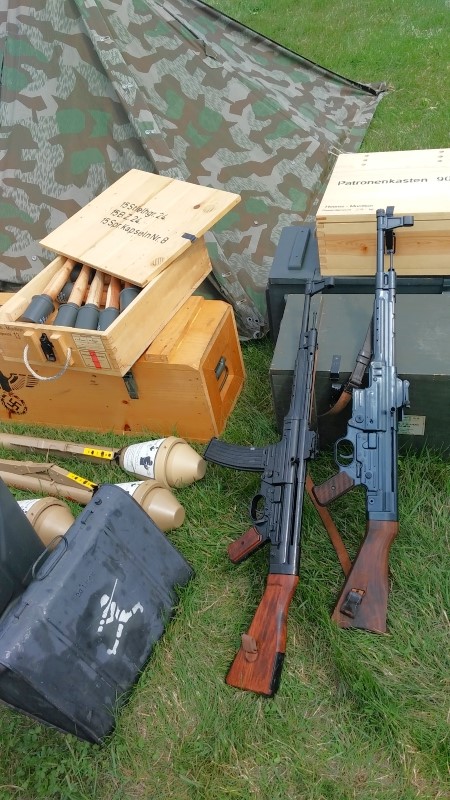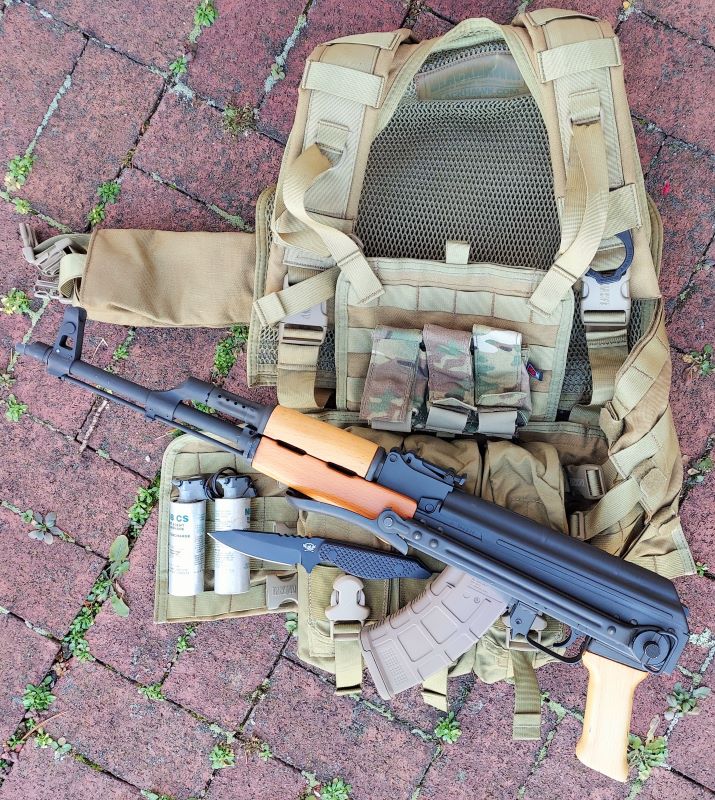Have you ever wondered how the AK-47 started out? Where did the idea come from – was it originally Russian? And how has it evolved over the years?
These are all good questions, ones that we’ll answer in this article.
The 1940’s
It all started back in the 1940s when Germany studied the variables of combat. How it took place, the typical ranges it occurred at, etc. They found that they rarely had to shoot more than 300 yards, and often the ranges were much closer. Germany realized that they didn’t need a full-sized rifle cartridge for regular combat, so they began designing a weapon around an intermediate-size cartridge. That cartridge turned out to be the 7.92x33mm (Kurz) round.
It was less potent than the 8mm Mauser cartridge but more powerful than the 9mm round, being intended to replace the role of both of those cartridges. The 7.92×33 throws a 125-grain Full Metal Jacket projectile about 2,250 feet per second. That’s pretty similar to the 7.62x39mm Soviet round – but more on that a bit later. It turned out to be less than a rifle, but more than a submachine gun, which was exactly the role that the Germans were after.
Enter the StG 44
German’s new Sturmgewehr (Assault Rifle) became an immediate hit with the troops who used it.

Made largely of stampings, it was faster and cheaper to produce than many other German arms. Its rate of fire on full auto was approximately 600 rounds per minute, making it fairly controllable. The weapon’s soft recoil also contributed to that controllability, and it was easy to field strip and care for in the field.
Ironically, Hitler did not want it produced, instead calling for more rifles and machine guns. The German military produced it behind his back. That is, of course, until he was visiting with some troops and he asked them what they needed, and they asked for more “Sturmgewehrs.” At that point, Hitler relented and got behind the program. However, for Germany, it was too little, too late. The war was already well beyond Germany’s winning.
Had they come out with the StG 44 earlier in the war, it might have made a more drastic difference for Germany.
As with a few other weapons systems that the Germans developed during WWII, the StG 44 was to have a ripple effect that lasted well down the road, and one that we’re still feeling today.
Soviet Copycats
The StG 44’s attributes were not lost on the Russians, who quickly realized the concept had major merit. First, they developed the semi-auto SKS rifle, which used the 7.62x39mm intermediate round. However, they wanted something closer to the Germans’ full-auto StG 44.
In 1941, Mikhail Kalashnikov, a machinist by trade, was recovering from wounds he received in combat. While still in the hospital, he designed the Avtomat Kalashnikova, which went on to be known as the AK-47. The “47” represents the first year that it was manufactured.

Lest anyone think that Kalashnikov’s first try was a success, it was not – it took a few revisions of the design to get it right before it was accepted. Internally, it is far from identical to the StG 44. However, it shares a number of external similarities that make it easy to see that the StG 44 was the influence behind the AK-47.
Technical Specifications
The weight of a standard AK-47 is around 7.7 lbs., with an overall length of 35″ with the fixed wooden stock. In the folding stocked versions, the overall length is closer to 34.4″. With the stock folded, the length is 25.4″.
The rate of fire is 600 rounds per minute with the effective firing range sitting close to 380 yards at its maximum. That’s a bit optimistic, I believe, as accuracy at such a range is difficult, given the AK’s sights.
The Cartridge
As mentioned, the Russians didn’t deviate very far at all from the Germans when they developed the M43 7.62x39mm cartridge that the AK-47 (and SKS) uses. It’s similar to the German 7.92x33mm round.
The 7.62x39mm was invented in 1943 and first used in the Soviet SKS carbines and features a bullet weight of around 123 grains and velocities of up to 2,350fps.

The 7.62x39mm has often been loosely compared to the American .30-30 Winchester round, which is a fair comparison. It’s a decently sized round moving at a modest velocity that gets the job done at realistic ranges. Like the Germans’ StG 44, the AK-47 is meant for intermediate combat ranges.
The Mission
The AK-47 is intended for conscripts who are not professional soldiers. It is designed to be easily field-stripped and maintained. Engaging targets out to a couple hundred yards at most is all it’s intended for.
The weapon is not polished or refined in the least; typically, they are very rough. That’s how they’re intended to be, as they’re not showpieces. It’s a tool and nothing more. Some shooters criticize the platform for these perceived shortcomings, but those shooters miss the point of what this rifle was created for.

Another point they’re criticized for is their accuracy (or lack thereof). At 100 yards, if you get one that shoots better than 4″ groups, you’re doing very well. The truth is, though, that for combat, this is basically adequate for the intended ranges.
Reliability
This is the area where the AK-47 truly shines. Reliability. The amount of abuse that this platform will take is nothing short of amazing. The loose tolerances go a very long way in allowing a lot of dirt and gunk to enter the system and still continue operating.
Recalling what I said recently about this rifle being issued to unmotivated conscripts, they tend to not be good at taking care of their gear. Terrorists can be the same way.
The average Viet Cong or Jihadist isn’t exactly a rocket scientist, nor are they adept at caring for weapons systems. As a result, there’s a good chance that the AK-47 won’t be cared for well. Or at all.
Lubing with motor oil is not out of the question. Pulling a knotted shoelace through the bore is the idea of “maintenance” by some tangos. Imagine treating some other weapons like this – how long would you expect them to continue operating? Probably not too long!
The AK works in swamps, it works in deserts, rainforests, jungles, the arctic…any place on earth that you can drag one of these rifles, it will manage to function, and do it with a bare minimum of maintenance. If you’re living in remote areas and don’t have the materials normally considered to be basic for caring for weapons, the AK is a good weapon to have.
With that said, the AK is not impervious; it can be stopped. If enough sand/dirt/mud/gravel, etc. is dumped into the action, it will actually stop working. But you really have to work at it to grind one to a halt.
Firing Characteristics
The recoil on the AK series is fairly tame. More than that of an M-16/M4, but certainly not extreme in the least. The 7.62x39mm is a relatively soft-shooting cartridge, intended to allow the AK to be controllable.
In semi-automatic, it’s easy to keep shots on target in a rapid fashion.
On full-auto, if bursts are kept short, it’s efficient at engaging targets rapidly at close range.
Who Uses Them?
Almost every damn body on earth! Russia and China supplied them to the NVA and Viet Cong back in the 1960s and 1970s to fight us in Vietnam. Since then, virtually every enemy (and some allies) of the United States has used them. Most recently, we’ve seen them used extensively in the various Middle Eastern wars.
A partial list of users (the full list would be too long): Albania, Algeria, Armenia, Bangladesh, Bosnia, Bulgaria, Cambodia, Chad, Chile, China, Congo, Cuba, Egypt, Ethiopia, Finland, Georgia, Hungary, India, Iran, Iraq…the list goes on and on. You get the picture – half the world (or more) uses this weapon in one form or another.

It has been estimated that there are approximately 75 million AK-47s in circulation to date. Of course, with all the various countries producing them, it’s impossible to know the real number.
Variants
Though it’s not the scope of this article to concentrate on the offshoots of the AK, it has spawned a number of variants. Light machine guns such as the RPK and RPD were derived from the AK-47. The AK-74 is essentially an AK-47 in 5.45mm. From that, the RPK-74 was also derived. Shortened versions have also been made of both of these platforms (nicknamed the “Krinkov”).
In 1974, the Russians developed the AK-74, which officially replaced the AK-47. However, the AK-47 was and is still widely used, given its massive numbers on the world scale.

The AK has been made with milled receivers as well as stamped receivers. Folding stocks are another option (both under-folders and side-folding stocks).
Other accessories include under-barrel grenade launchers, which are similar to the M-16’s M-203. Various optics, including night vision, are also common for the AK series.
Final Thoughts
Mikhail Kalashnikov’s creation has become possibly the most recognized (and produced) firearm in world history. Its durability and ease of maintenance have elevated it to mythical status and made it attractive to armies and terrorist organizations alike. Not to mention, citizens who like it for the same merits.
It’s safe to say that the AK-47 is going to be around for many decades to come – they just won’t die!


